
Geisenheim is a town in the Rheingau-Taunus-Kreis in the Regierungsbezirk of Darmstadt in Hessen, Germany, and is known as Weinstadt, Schulstadt, Domstadt and Lindenstadt.
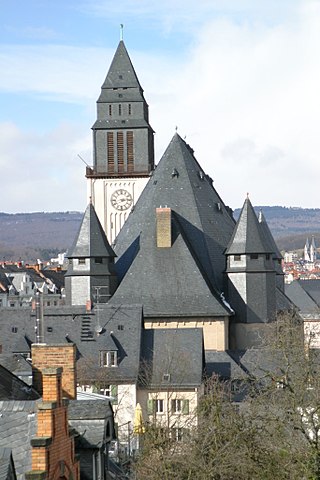
The Lutherkirche is one of four main Protestant churches in Wiesbaden, the capital of Hesse, Germany. It was built between 1908 and 1910 in Jugendstil and in accordance with the Wiesbadener Programm, to a design by Friedrich Pützer. With two organs and good acoustics, it is also a concert venue.
Andreas Pruys is a German classical bass singer.
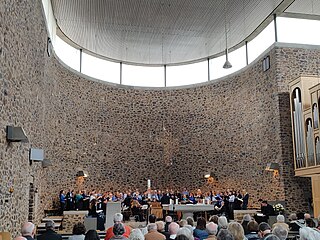
St. Martin is the name of a Catholic parish and church in Idstein, Rheingau-Taunus-Kreis, Germany. The official name of the church is Katholische Pfarrkirche St. Martin. The name of the parish became St. Martin Idsteiner Land on 1 January 2017, when it was merged with five other parishes. The parish is part of the Diocese of Limburg.
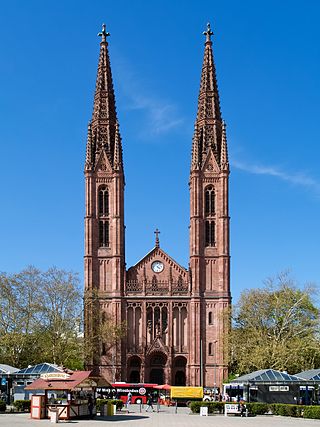
St. Bonifatius in Wiesbaden, Germany, is the central Catholic parish and church in the capital of Hesse. The present building was designed by architect Philipp Hoffmann in Gothic Revival style and built from 1844 to 1849. Its twin steeples of 68 m (223 ft.) dominate the Luisenplatz. The parish is part of the Diocese of Limburg.
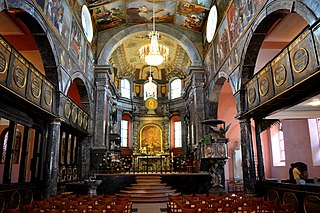
The Unionskirche is the active Protestant parish church of Idstein, a town in the Rheingau-Taunus district in the German state of Hesse. Idstein was a residence of the counts of Nassau. The church building in the center of the historic Altstadt dates back to the 14th century when it was built as a collegiate church. It became Lutheran during the Reformation. Its interior was adapted in the 17th century to become a Lutheran Predigt- und Hofkirche. The most prominent decoration in the church is the series of 38 paintings by the Flemish painter Michael Angelo Immenraedt, an exponent of Flemish Baroque painting, and others. They follow a program of biblical scenes.

The Ringkirche is a Protestant church in Wiesbaden, the state capital of Hesse, Germany. The Romanesque Revival church was built between 1892 and 1894 and designed by Johannes Otzen. The historic monument also serves as a concert venue.

Philipp Hoffmann was a German architect and builder, principally known for his work in the Nassau capital in Wiesbaden.

Rheingauer Kantorei, now Neue Rheingauer Kantorei, is a mixed choir of the Rheingau region in Germany, performing mostly sacred music in services and concerts.

St. Valentin is the common name for the Catholic parish church and Basilica minor Basilica of SS Dionysius and Valentinus in Kiedrich in the Rheingau, in Hesse, Germany. It was built at the end of the 15th century in the Gothic style. Its organ is one of the oldest playable organs in Germany. The church was a pilgrimage destination for people with epilepsy and therefore has notable carved wooden laity stalls, including one decorated with the "Gerechtigkeitsspirale".
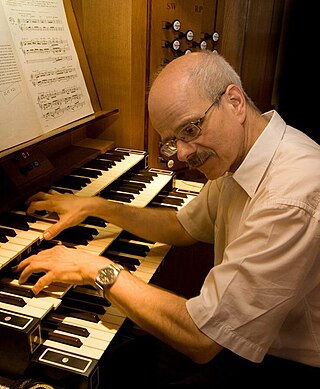
Martin Lücker is a German classical organist, and professor at the Hochschule für Musik und Darstellende Kunst Frankfurt am Main.
Frank Stähle was a German musician, a choral conductor and the director of Dr. Hoch's Konservatorium in Frankfurt from 1979 to 2007.

St. Jakobus is a Catholic church and a former parish in Rüdesheim am Rhein, Hesse, Germany. It dates back to the 10th century, was expanded around 1400, and again in 1913/14. The church was severely damaged by bombing in World War II, and rebuilt from 1947 to 1956. It is a listed historic monument and serves also as a concert venue.

Idsteiner Kantorei is a mixed choir in Idstein, Rheingau-Taunus-Kreis, Germany. The group performs regularly in the Protestant Unionskirche in services and concerts, also in smaller churches of the region and internationally. They practice collaboration with other choirs for larger projects.
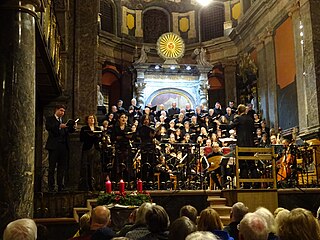
Carsten Koch is a German organist, choral conductor and academic. He is the church musician at the Unionskirche in Idstein, Hesse, conducting the concert choir Idsteiner Kantorei and the orchestra Nassauische Kammerphilharmonie that he founded. He lectured orchestral conducting at the Frankfurt University of Music and Performing Arts.

St. Martin is a Gothic church and the associated Catholic parish in Lorch am Rhein, Hesse, Germany. In 2002, it became part of the Rhine Gorge, a UNESCO World Heritage Site. The church features the oldest and largest monochrome wood-carved altar in Germany. Its organ from 1984 makes it also a concert venue, where international organists such as Olivier Latry have performed.

St. Nikolaus von Flüe is the name of a Catholic church in Wörsdorf, part of Idstein, Rheingau-Taunus-Kreis, Germany. The official name of the church is Katholische Pfarrkirche St. Nikolaus von Flüe. When it was dedicated, the name was St. Nikolaus-von-Flüe-Friedenskirche, designating it as a peace church. The Wörsdorf parish belongs to St. Martin Idsteiner Land. The church, the first Catholic church in Wörsdorf, was designed by Johannes Krahn, and consecrated in December 1962.

St. Bonifatius is a Catholic church in Lorchhausen, part of Lorch, Hesse, Germany. The large church in Gothic revival style was completed in 1879.
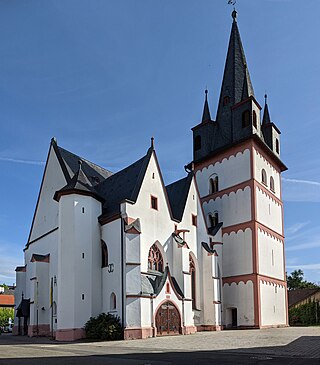
St. Martin is the name of a Catholic church and former parish in Oestrich, Rheingau-Taunus-Kreis, Germany. It was built as a hall church from 1508 in late-Gothic style. It was destroyed in the Thirty Years' War and rebuilt in simpler style, but restored to its Gothic appearance in 1894.

St. Hildegard is a Catholic pilgrimage church and a former parish church in Eibingen, part of Rüdesheim am Rhein, Hesse, Germany. Its full name is St. Hildegard und und St. Johannes der Täufer because it not only dedicated to Hildegard of Bingen but also to John the Baptist. It was built on the ruins of the abbey church that Hildegard founded; her relics have been in the church since 1641. The walls around its grounds with a cemetery still date back to her time, as well as monuments in the church's floor. The parish belongs now to the Rheingauer Dom in Geisenheim.

























